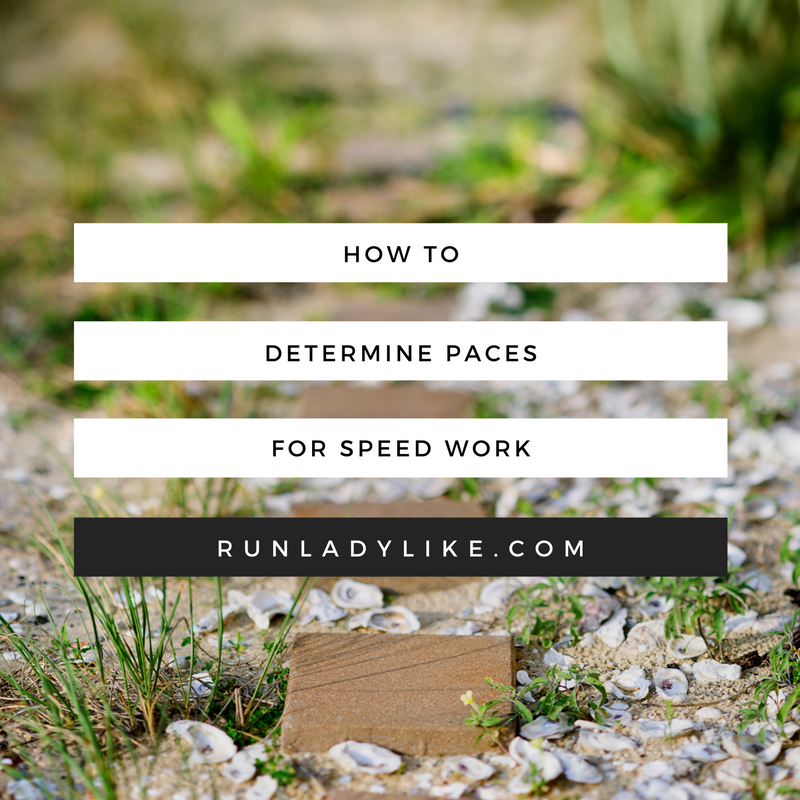How to Determine Paces for Speed Work
We all know that the only way to start running faster is to … (drum roll please) … start running faster. By incorporating speed work into our training, we can teach our bodies to actually run faster by increasing our speed. I’ve written before about the types of speed workouts and how to begin safely incorporating them into your training, but you might be wondering: How fast should I be running? Am I running too fast or too slow? How do I figure that out? Today, I’m sharing some basic guidance for how to determine paces for speed work. I’ve personally seen a significant improvement in my running and race times since I started running the RIGHT speed work paces. For several years, I was running too slow and only by feel rather than knowing what I should be targeting and how to push myself outside of the right comfort zone.

Before you begin crunching numbers, here are a few things you need to know and remember when it comes to starting speed work and determining paces for speed work:
- Know your current 5K time. Not the time you want to run a 5K in; your most recent 5K time. That is a great tool for setting your speed work paces. Not only does it use your current fitness level to ensure you don’t set paces that could increase your risk of injury, but you can also increase your speed work paces as your 5K time gets faster.
- Speed work is the cause of many running injuries. Incorporate it appropriately. Speed work should only be incorporated into your training after you have established a solid running base. You can read more about base-building and training cycles here. What you want to avoid is doing too much, too fast. Once speed work is incorporated, it should only be done once per week and should only comprise about 15 percent or so of your weekly mileage. Don’t increase your speed and distance at the same time.
- Your pace for speed work should always be faster than your race pace. Going too fast will lead to injury, while going too slow will prevent you from improving. Knowing your paces can help you hit that sweet spot.
- If you use a heart rate monitor, speed work paces should yield a heart rate of about 90-95 percent of your Maximum Heart Rate. (We’ll talk more about heart rate training in the coming months.)
- Warm-up properly. Preventing injury and having a successful speed session requires a serious focus on properly warming up. This includes slow jogging and dynamic stretches. You can find a recommended warm-up protocol here. A proper cool down is also key to promote healing and prevent injury.
- Adequate recovery between intervals is key. Between each speed repeat, easy walking or jogging is a must to bring your heart rate down. Most conditioned runners will need a recovery equal to about half the distance of the intervals, while beginners may need a little more time.
So, how fast should you be running?
The North American Academy of Sport Fitness Professionals recommends calculating your interval paces based on percentages of your race pace. I use current 5K pace.
- 100-meter intervals should be run at 15% faster than your 5K pace.
- 200-meter intervals should be run at 12% faster than your 5K pace.
- 400-meter intervals should be run at 10% faster than your 5K pace.
- 800-meter intervals should be run at 8% faster than your 5K pace.
- 1,000-meter intervals should be run at 6% faster than your 5K pace.
As an example, if your current 5K pace is 7:05/mile, that means you would run your intervals at the following paces:
- 100s: 6:01/mile
- 200s: 6:14/mile
- 400s: 6:23/mile
- 800s: 6:31/mile
- 1,000s: 6:40/mile
To make the process even simpler, you can use speed work pace calculator charts based on your current 5K time. My favorites are:
- The pacing charts in the book Run Less Run Faster. I am a die-hard believer in these and use them regularly for my own training. The paces outlined for me in Run Less Run Faster are very similar to the manual calculations done above.
- The McMillan Running Calculator (Just be sure to find your paces based on your CURRENT 5K time, not your desired marathon/half marathon goal). I think these paces tend to be a little faster than the Run Less Run Faster times, so I prefer those over these.
Speed work intervals should be appropriate for the race you are training for. While you might run 100-meter and 200-meter repeats if you are training for a 5K or 10K, you would likely do more 400-m, 800-m and 1-mile repeats if you are training for longer distance races. Common speed workouts I do include: 6 to 16 400-meter repeats with a 400-m recovery between each, 6 to 8 800-meter repeats with a 400-meter recovery between each, 5 x 1,000-meter repeats with a 400 to 500-meter recovery between each and 3 x 1-mile repeats. I also mix up 400s, 600s, 800s and 1,200s occasionally in the same workout.
More ways to connect with rUnladylike:
Twitter: @rUnladylike
Facebook: https://www.facebook.com/runladylike
Instagram: http://instagram.com/runladylike/
Daily Mile: http://www.dailymile.com/people/jesica
Pinterest: http://www.pinterest.com/JesicaD/
Follow rUnladylike with Bloglovin
Do you incorporate speed work into your training? If so, have you been running the right paces for your current fitness level based on the calculation guides above? Do you have a favorite speed workout?



Comments
Thanks, this was very informative! I recently started to work on my speed. Previously, I mainly targeted increasing the length of my runs, but now I want to train for speed for a 10K
Good info. I have used McMillan to calculate my training paces. It is important to be realistic and use your current 5k pace to determine training goals vs. your ultimate goal. I learned that the hard way and it set me back months.
Thanks for this info. I don’t get how to calculate it though. Do you mean that the pace for the 100 m intervals should be 15% FASTEr than 5k pace? Sorry I’m new to this.
Hi Ida, I’m sorry that wasn’t clear. 🙂 Yes, you should run 15 percent faster than your 5K pace for 100s, 12 percent faster for 200s, etc. The best way to do this is to convert your minutes per mile to seconds. For instance, I run a 7:05/mile pace for my 5K, which is 425 seconds per mile. Multiply that by the appropriate percentages (e.g. 0.15, 0.12, etc.) and that will yield how many seconds faster you need to run on top of your current 5K pace. (Example: For 100s, I would multiply my current 5K pace in seconds (425 seconds per mile) by 15 percent (0.15). That equals about 63-64 additional seconds. So, I would run 63-64 seconds faster per mile than a 7:05, which works out to be around 6:01/mile pace.) Let me know if I can explain that better or answer more questions 🙂
Do you use the same approach for determining your training pace regardless of if you are training for a stand alone road run or a triathlon?
Hi Lee. Yes, for running I use the same paces regardless of race type … the actual speed workouts just vary. For intervals and tempo rides on the bike, using heart rate is a great gauge to determine pace.
Great tips on gaining speed! I do speed work and actually enjoy it. It’s tough but the challenge is fun for me. I used to only run 400 repeats but lately I’ve been mixing it up with ladder workouts, running at different paces for a specific time and just good ole Tempo runs. I have always used the McMillan Running Calculator to help with paces. It’s a great resource!
This is so helpful! I always wonder how to find our my speed pace and never really know the proper time I should be training in or what to do! SO helpful!
I am using Runner’s World SmartCoach and thankfully it follows these rules too 🙂 I’m excited to have a real outline for my speed work since I’ve got big goals for this spring!
Very informative – thank you for sharing. I will have to go back and check myself with my speed work to see if my times are on the mark.
Great advice! I’m trying to be more disciplined about weekly speed work.
[…] How to Determine Paces for Speed Work from rUnladylike […]
Thanks ! It was probably clear to most people but thanks for clarifying for me. I love your blog
Thank you so much, Ida!!!
Sound advice.
I started doing speedwork once a week. I have to be very careful because I suffered from high hamstring tendinitis. But running those 800m intervalls with recovery in between is actually fun!
Thank you for that post
Very informative! I had plantar fasciitis in the past and it has been gone for about 4 months now, so I am hesitant to incorporate speed work just yet. I do fartlek intervals and running strides, however, so that helps.
My husband bought Run Less, Run Faster for me a few months ago. I was already in the middle of marathon training and didn’t want to totally switch gears, but now that I’m almost through with my spring race calendar, I’m looking forward to switching things up and trying their plans.
One day I’ll get to the sub-2 half!! 🙂
Yes you will, Kristin!!! Let me know what you think if/when you start using the plan. I really like their speed pacing suggestions and workouts. Happy training!
[…] Crunch Warning: Reading This Will Improve Your Strength Training ASAP – Lifting Revolution How to Determine Paces for Speed Work – Run Lady Like 30-Minute Running Intervals Treadmill Workout – It’s […]
Hello! I recently stumbled across your blog and thought I’d finally say HI! Last summer I tried to incorporate “speed workouts” into my routine by running timed 400s and 800s every other week and increasing the number of runs by 1 each time. HOWEVER, I did not target a specific time. Although my pacing seemed to even itself out over time, I think this would be a good method for me to try 🙂 Thanks for sharing!
Hi Jen! Thank you so much for stopping by! I’m so glad you said hello! I’m glad this post was helpful to you. Just remember to start slow and base your time off your current fitness, not desired fitness to reduce risk of injury. I hope you’ll keep me posted on how your training goes. So happy and honored to have you as a reader. xo
[…] Do not run your speed work paces faster than your current fitness will allow. To help you determine your speed work paces, know your current 5K time and calculate your speed paces here. […]
I just found this post and it was sooo helpful! I am training for my 3rd half marathon beginning this week but this is the first time I’m training without a group, so I have to figure this stuff out for myself this time.
Thanks so much for stopping by runladylike.com Chaitali! I’m so glad this post was helpful. Best of luck with your half marathon training. The key is to start speed work based on your current fitness level not a goal fitness level you are not currently at that could cause injury. Speed work will be a game changer for you if you haven’t already been doing it. Start slowly and gradually to stay safe and healthy. Good luck! xo